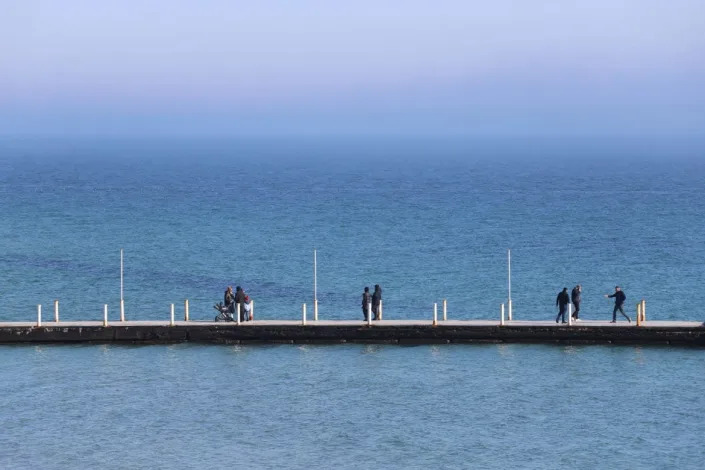Ukrayinska Pravda
Luhansk Oblast: Ukrainian Armed Forces destroy Russian ammunition depots, Russian subversion and reconnaissance groups ramp up their activity
Iryna Balachuk – July 13, 2022
Serhii Haidai, head of the Luhansk Oblast Military Administration, has reported that the Ukrainian Armed Forces are destroying Russian ammunition depots and neutralising Russian subversion and reconnaissance groups almost on a daily basis.
Source: Serhii Haidai on Telegram
Quote: “The Russian army continues its relentless shelling [of Luhansk Oblast – ed.]. However, the Russians are probably saving their ammunition stockpile because new supplies have been interrupted by the attacks of our new long-range weapons.
[Russian – ed.] Military depots in Kadiivka and Luhansk have recently been blown up. Last night, there was turmoil in the Luhansk industrial district. So the occupiers have once again deployed subversion and reconnaissance groups in order to look for weak spots in our defence. The ramping up of the subversion and reconnaissance activity is due to their shortage of ammunition.”

Details: Haidai said that the Russians are applying pressure not only from Lysychansk and Popasna, but also from Izium.
He noted that though the Russians are still far from the Ukrainian-held towns and villages in Luhansk Oblast, their actions might threaten bigger cities in Donetsk Oblast and force the Ukrainian Armed Forces to construct new defence fortifications.
The head of the Luhansk Oblast Military Administration also said that Russian occupying forces continued to use artillery and aircraft to apply pressure on the administrative border area between Donetsk and Luhansk oblasts. In particular, the Russians are attacking Verkhnokamianske and Bilohorvika, which sustained four rocket strikes and two airstrikes in the past 24 hours.
In addition, Russian occupying forces opened artillery fire on civilian residential buildings in these two villages 13 times over the course of the past 24 hours.

https://openweb.jac.yahoosandbox.com/0.8.1/safeframe.htmlhttps://s.yimg.com/rq/darla/4-10-1/html/r-sf.html
Related:
Associated Press
Ukraine reports striking Russian ammunition depot in south
Maria Grazia Murra – July 12, 2022

ASSOCIATED PRESS

ASSOCIATED PRESS

ASSOCIATED PRESS
KYIV, Ukraine (AP) — The Ukrainian military on Tuesday reported destroying a Russian ammunition depot in southern Ukraine, resulting in a massive explosion captured on social media, while authorities said the death toll from a weekend Russian strike in the country’s east grew to 41.
An overnight rocket strike targeted the depot in Russian-held Nova Kakhovka, the Ukrainian military’s southern command said. Nova Kakhovka is located about 35 miles (55 kilometers) east of the Black Sea port city of Kherson, which is also occupied by Russian forces.
The precision of the strike suggested Ukrainian forces used U.S-supplied multiple-launch High Mobility Artillery Rocket Systems, or HIMARS, to hit the area. Ukraine indicated in recent days that it might launch a counteroffensive to reclaim territory in the country’s south as Russia bombards the eastern Donbas region.
Russia’s Tass news agency offered a different account of the blast in Nova Kakhovka, saying a mineral fertilizer storage facility exploded, and that a market, hospital and houses were damaged in the strike. Some of the ingredients in fertilizer can be used for ammunition.
A satellite photo taken Tuesday and analyzed by The Associated Press showed significant damage. A massive crater stood precisely where a large warehouse-like structure once stood in the city,
Ukraine now has eight of the HIMAR systems, a truck-mounted missile launcher with high accuracy, and Washington has promised to send another four.
Elsewhere in Ukraine, Russian shelling over the past 24 hours killed at least 16 civilians and wounded 48 more, Ukraine’s presidential office said in its Tuesday morning update. Cities and towns in five southeast regions came under Russian fire, the office said.
Nine civilians were killed and two more wounded in Donetsk province, which makes up half of the Donbas. Russian rocket attacks targeted the cities of Sloviansk and Toretsk, where a kindergarten was hit, the presidential office said.
The British military said Tuesday that Russia was continuing to make “small, incremental gains” in Donetsk, where heavy fighting led the province’s governor last week to urge its 350,000 remaining residents to move to safer places in western Ukraine.
The death toll from a Russian rocket attack that struck a Donetsk apartment building Saturday rose to 41, the emergency services agency said Tuesday afternoon. It said four more bodies were found and nine people were rescued from the rubble of the building in Chasiv Yar.
Yet many in the Donbas, a fertile industrial region in eastern Ukraine made of Donetsk and Luhansk provinces, refuse — or are unable — to flee, despite scores of civilians being killed and wounded each week.
In Kharkiv, Ukraine’s second-largest city, and its surrounding region, Russian strikes hit residential buildings, killing four civilians and wounding nine, Ukrainian officials said.
“The Russians continue their tactics of intimidating the peaceful population of the Kharkiv region,” Kharkiv Gov. Oleh Syniehubov wrote Tuesday on Telegram.
Ukrainian authorities also said that Russian fire struck the southern city of Mykolaiv on Tuesday morning, hitting residential buildings. Twelve people were wounded as the result of the Russian shelling, with some of the rockets hitting two medical facilities, regional governor Vitaliy Kim said on Telegram.
Air raid sirens sounded Tuesday in the western city of Lviv — the first daytime sirens there in over a week — and in other areas of Ukraine as Russian forces continued to make advances.
In eastern Luhansk, “fighting continues near the villages” on the administrative border with neighboring Donetsk, Luhansk Gov. Serhiy Haidai told the Associated Press on Tuesday.
“The Russian army burns down everything in its way. The artillery barrage doesn’t stop and sometimes continues for four to six hours on end,” Haidai said.
The British Defense Ministry’s intelligence briefing said Russia had seized the Ukrainian town of Hryhorivka and continued to push toward the Donetsk province cities of Kramatorsk and Sloviansk.
“Russian forces are likely maintaining military pressure on Ukrainian forces whilst regrouping and reconstituting for further offensives in the near future,” the intelligence briefing said.
However, Russia may be relying more heavily on private military contractors, like the Wagner Group, to avoid a general mobilization, the British ministry said. Western officials have accused Wagner of using mercenaries to fight in Africa and elsewhere.
In other developments:
— The Kremlin said Russian President Vladimir Putin would visit Iran next week. Kremlin spokesman Dmitry Peskov said that Putin will travel to Tehran next Tuesday to attend a trilateral meeting with the leaders of Iran and Turkey, a format for Syria-related talks. U.S. National Security Adviser Jake Sullivan told reporters on Monday that Russia was seeking hundreds of surveillance drones from Iran, including weapons-capable ones, for use in Ukraine.
— Russian and Turkish military representatives plan to meet in Istanbul on Wednesday to discuss the transport of Ukrainian grain through the Black Sea, a Russian Foreign Ministry official said. Pyotr Ilyichyov, head of the ministry’s department for international organizations, told Russian news agency Interfax that “representatives of Ukraine, as well as U.N. (officials) in the role of observers” are also expected to take part in the talks. Ilyichyov reiterated that Moscow was ready “to assist in ensuring the navigation of foreign commercial ships for the export of Ukrainian grain.”
— Germany’s justice minister said investigating war crimes in Ukraine would likely take “many years” but he was confident they ultimately will be successful. Justice Minister Marco Buschmann said there will “probably be hundreds of thousands, maybe even millions of pieces of evidence that have to be sifted through, documented and evaluated.” The German federal prosecutor’s office said in early March that it had started looking into possible war crimes committed by Russian forces in Ukraine. Buschmann spoke Tuesday in Prague, where he and his European Union counterparts were meeting.
Jon Gambrell in Lviv, Ukraine, and Isabel DeBre in Dubai, United Arab Emirates, contributed to this report.











